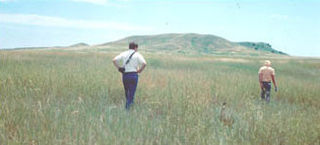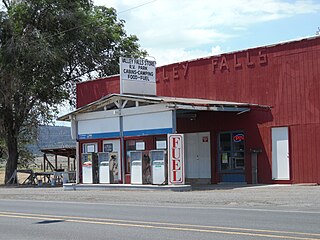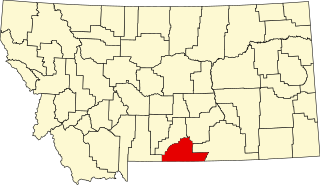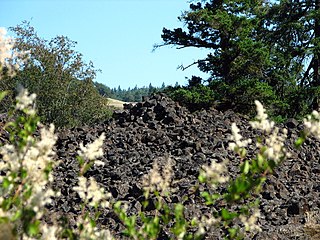
Fort Rock Cave was the site of the earliest evidence of human habitation in the US state of Oregon before the excavation of Paisley Caves. Fort Rock Cave featured numerous well-preserved sagebrush sandals, ranging from 9,000 to 13,000 years old. The cave is located approximately 1.5 miles (2.4 km) west of Fort Rock near Fort Rock State Natural Area in Lake County. Fort Rock Cave was declared a National Historic Landmark in 1961, and added to the National Register of Historic Places in 1966.

The Langdeau Site, designated by the Smithsonian trinomial 39LM209, is an archaeological site in Lyman County, South Dakota, near Lower Brule. It was declared a National Historic Landmark in 1964. The site was one of the first to provide evidence of horticultural activity by Native Americans in the region.

Valley Falls is a small unincorporated community in Lake County, Oregon, United States. The settled area is located at the junction of U.S. Route 395 and Oregon Route 31. The community is named for a small falls on the Chewaucan River just north of the occupied site. East of Valley Falls, the cliff face of Abert Rim overlooks the community.

The Greaser Petroglyph Site is located on land managed by the Bureau of Land Management in eastern Lake County, Oregon. The designs were scraped into a basalt boulder by Native Americans perhaps 12,000 years ago. No one knows the meaning of the designs. Because of its unique archaeological and cultural significance, the Greaser Petroglyph Site was listed on the National Register of Historic Places in 1974.

This is a list of the National Register of Historic Places listings in Carbon County, Montana.
Palo Hincado Site, also known as BA-1, is an archeological site in or near Barranquitas, Puerto Rico. The site includes a plaza, a 33 metres (108 ft) by 15 metres (49 ft) ball court, and petroglyphs. Reportedly a number of petroglyphs on stones around the plaza and ball court) have been removed by collectors.

The Bellows Falls Petroglyph Site is an archaeological site containing panels of precontact Native American petroglyphs in Bellows Falls, Vermont. Located near the Vilas Bridge on bedrock west of and above the Connecticut River, adjacent to Great Falls, they depict a rarely-seen assemblage of anthropomorphic figures that is believed to be unique in New England, and uncommon even in surrounding geographic areas. The site was listed on the National Register of Historic Places in 1990.

The Mosier Mounds Complex, also known locally as the Mosier Battlements, is an archaeological site near Mosier, Oregon, United States. This collection of stone walls, pits, and mounds amid a basalt talus slope is the largest and most complex of a number of similar Native American sites in the southern Columbia Plateau. The site predates the arrival of Europeans and probably the local ascendance of Chinookan peoples, but has resisted more precise dating or cultural affiliation.

The Fivemile Rapids Site, is an archaeological site near The Dalles, Oregon, United States. Yielding remains beginning soon after the end of the last glacial period, this and other nearby sites provide a nearly continuous record of human occupation from at least 9000 BCE to 1820 CE. It also provides some of the earliest available evidence of fishing in human economy.

The Umatilla Site is an archaeological site near Umatilla, Oregon, United States. Situated on the shores of the Columbia River, the prehistoric component of the site is associated with the origins of seasonal (winter) sedentism around fishing opportunities. Pit houses at Umatilla date to at least 470 BCE, and significant evidence is present of occupations earlier than the pit houses. Other remains found include stone and bone art objects, burials, and extensive animal remains. The total set of remains may represent the largest prehistoric site in Oregon by area. The site may also yield useful evidence of the historical period of the town of Umatilla, founded over the prehistoric remains in the 1860s as a gold mining supply base and relocated in 1967 in connection with the construction of the John Day Dam.

The East Lake Abert Archeological District is an area in Lake County, Oregon, United States, that features numerous prehistoric camp sites and petroglyphs. It is located along the eastern shore of Lake Abert on land administered by the Bureau of Land Management and the Oregon Department of Transportation. The site includes stone-walled house pits and prehistoric rock art made by ancient Native Americans who occupied the site for approximately 11,000 years. Because of its unique archaeological and cultural significance, the East Lake Abert Archaeological District was listed on the National Register of Historic Places in 1978.
The Blueberry Lake Village Site is a prehistoric Native American archaeological site in Blueberry Township, Minnesota, United States. It consists of a habitation site, possibly seasonal, whose period and duration of occupation is uncertain. It was listed on the National Register of Historic Places in 1973 for having state-level significance in the theme of archaeology. It was nominated as one of the few surviving archaeological sites in the Shell River basin of northwestern Wadena County, the region's most conducive zone for prehistoric human habitation.
The Winooski Archeological Site, designated VT-CH-46 by state archaeologists, is a prehistoric Native American site in the city of Winooski, Vermont. First identified in 1972, it is one of the largest Native encampment sites of the Middle Woodland period in the northeastern United States. It was listed on the National Register of Historic Places in 1978, at which time it was recognized as one of just two stratified Woodland period sites in the state.
The Orwell site, designated 21OT7 in the state archaeological inventory, is a historic site located near Fergus Falls, Minnesota, United States. It consists of twelve Middle or Late Woodland period burial mounds, four of which are enclosed by an earthwork. They were built from about A.D. 350–600. They share similarities with the mounds found at Fort Juelson, also in Otter Tail County, with their central burial chamber. The site was listed on the National Register of Historic Places in 1974.
Cueva La Mora is the name of a cave and archaeological site located in or near Comerío, Puerto Rico. The cave was added to the United States National Register of Historic Places on March 10, 1983, due to its importance in yielding information about the Pre-Columbian history of Puerto Rico and the Caribbean.














